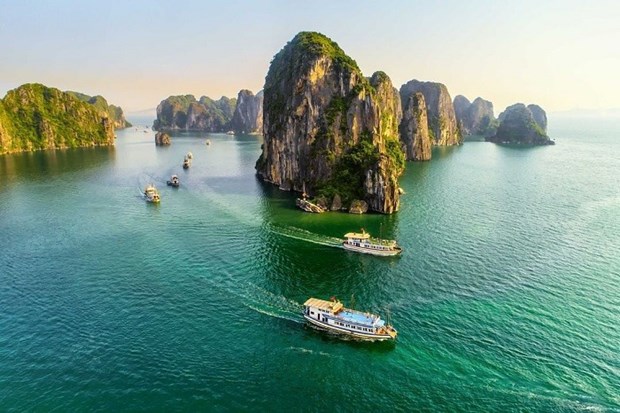Marine tourism needs more focus on full exploitation
In its tourism development strategy by 2030, Vietnam identified marine tourism as one of the four main groups of tourism products, but there remains much to be done to fully tap into marine tourism potential.
 Ha Long Bay in Quang Ninh province is a favourite destination of domestic and foreign tourists. (Photo: VNA)
Ha Long Bay in Quang Ninh province is a favourite destination of domestic and foreign tourists. (Photo: VNA)With more than 3,260km of coastline, about 3,000 islands of all sizes, hundreds of beautiful beaches, and pristine bays, Vietnam boasts rich resources for developing sea and island tourism.
During 2010 - 2019, before the COVID-19 pandemic broke out, the number of visitors to coastal localities increased faster than the average growth in the total tourist number, at an annual rate of 13.6% for international arrivals and 12.3% for domestic ones.
In 2019, foreign tourists coming to the 28 coastal provinces and cities accounted for 71.9% of all international arrivals in Vietnam while domestic visitors 59% of the domestic travellers. The tourism revenue in these cities also made up 67% of the total. The number of rooms at their accommodation establishments was also equivalent to two-thirds of that nationwide. Most of four- and five-star hotels are also located in these areas, according to the Vietnam National Administration of Tourism (VNAT).
However, many experts said that such figures have yet to match Vietnam’s marine tourism potential.
Addressing a recent workshop, Deputy Minister of Culture, Sports and Tourism Doan Van Viet perceived that the country has just focused on tapping into the values of inshore maritime resources, and there haven’t been many services other than such traditional activities as relaxation, sightseeing, or bathing.
While the duration of tourist stays in coastal and insular destinations is still short, marine tourism, especially in the northern region, is highly seasonal, and there is a shortage of high-end marine tourism products, Director of the VNAT’s Institute for Tourism Development Research Nguyen Anh Tuan pointed out.
 An aerial view of May Rut Islet, one of the most beautiful of its kind in the island city of Phu Quoc, Kien Giang province (Photo: VNA)
An aerial view of May Rut Islet, one of the most beautiful of its kind in the island city of Phu Quoc, Kien Giang province (Photo: VNA)Besides, there remains much room for Vietnam to attract cruise ship tourists, but the country still lack vessels large enough to carry several thousand holidaymakers, he noted.
Ha took the case of Lan Ha, Ha Long, and Bai Tu Long bays an another example, elaborating that the three bays are adjacent to one another but it is hard to launch tours linking the bays since they belong to two localities – Quang Ninh province and Hai Phong city.
He underlined the need to issue a strategy for developing marine tourism more sustainably and harmoniously. Policies should be revised in a way further facilitating sea, island, and bay tours. Environmental issues, particularly plastic waste control, also need to be taken into consideration as travellers are paying more attention to responsible tourism.
Vu Duy Vu, a representative of Saigontourist, said some popular destinations of international cruise ships still lack specialised terminals for those vessels. Vietnam should invest more in facilities capable of handling giant cruise ships without having to use small boats to carry tourists from those liners to destinations.
It is necessary to cooperate with other countries so that Vietnam can become an official player in the regional cruise tourism market, he said, also highlighting the need for localities to support and encourage cruise companies to choose Vietnam as a destination of their journeys.
Tuan said that to develop marine tourism sustainably, it is important to conduct zoning to align tourism development with specific advantages and target markets of each region, locality, destination, and the country as a whole.
He also recommended more investment be poured into infrastructure, particularly tourist ports, diversify and improve the quality of tourism products to meet different markets’ demand, and pay due attention to environmental protection and tourist serving capacity./.












